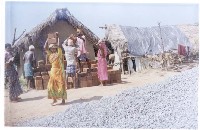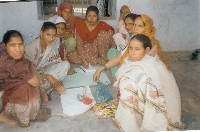| Towards Adequate Habitat for all in Rural India For far too long have governments and other agencies looked at the issue of rural habitat and housing as an issue primarily revolving around the “house”, compartmentalizing it from the issues of land, connectivity, livelihood, capacity building and resources. And most of all, separating it from the rural habitat – the settlement, the infrastructure, the natural resource base and the social fabric it rests in.
The house of a rural family is a resultant of a complex interaction of all the above elements. The society in rural India is not a homogeneous mass of population dependent on agriculture-based activities. Economically, one could easily witness at least three to four segments in the rural scenario. There are the rural rich, not lacking in material comforts, limited, if at all, to reach their desired quality of life by the lack of habitat infrastructure such as roads, drains, electricity and connectivity. The rural middle class people are upwardly mobile, discerning spenders and, along with the rural rich, are now the focus of many FMCG companies who desire to reach out into the rural markets. There is a growing segment of the rural population on the threshold of the economic mainstream today, fuelled by the processes of the Self Help Group (SHG) movement. The economic mobility of the families has been a resultant of the women’s habit of saving money along with the creditworthiness amongst women’s groups initiated through the years of effort put in by the multitude of rural NGOs. The strength of social and economic solidarity has created a strong women’s force – Stree-Shakti, leading to a healthy entrepreneurial temper, a quantitative change in the family economy and a qualitative change in the life of families associated with the SHG movement. In many regions, the SHG movement has challenged the existing rural socio-political scenario, influencing a positive change in the rural society within the village settlements, and also contributed towards taking informed decisions regarding their habitat conditions. Large differences, however, exist in this movement between the North and South of India.
The SHG movement has matured to a large extent in the South, wherein micro-credit institutions, banks and technical service institutions are providing support and facilitating rural families to enhance their economic and physical assets. The North of India is clearly lagging behind. The lack of strong facilitating institutions, the hesitation in the banking sector to support the groups, the poor influence women have on their social, political and economic space within families and village societies as compared to their southern counterparts, is a clear indication that there is much catching up to do. Finally, there are the rural poor and the very poor subsisting below the poverty line, mostly with neither a piece of land nor a single asset, especially tribal and non-tribal families who have been deprived both socially and economically over generations. The limitations that this huge mass of rural poor of almost two million families across India faces are not merely economic in nature. Yet, the lack of stable livelihoods is probably the first barrier that needs to be broken to bring in hope and a possibility of mobility in their lives. All efforts to “house” this population are inadequate in the absence of any adequate rural infrastructure, especially livelihood infrastructure and job opportunities. The challenge confronting us is how to accelerate the process of rural development, especially habitat improvement in this complex framework. The response has to be as multi-faceted as the problem at hand. Examples of addressing the village as a whole as in Orissa1, as a network of village Panchayats as in Tamil Nadu2 or as a basic unit for the habitat (and livelihood) micro-plan as in Kerala3 have shown that it is possible to have hut-less villages, with sustainable inter-dependent economies and a gradual but definite diversification in the livelihood base and enhanced socio-economic and technological capacities of people – all resulting in an improved habitat. Very critical to this process, whether it be Tamil Nadu, Orissa or Kerala, are the supporting and facilitating institutions. These range from the grassroots NGOs and agencies that work towards social integration, capacity building, technical services provision and livelihood creation, to banks and micro-credit institutions providing finance and credit for livelihood and infrastructure up-gradation and strong local governance bodies - the Panchayats.
If we very broadly classify the rural habitat problem today into the equation of demand and supply, then the issue of demand creation, especially for the poor, is not just one of creating the “paying capacity”. Much work needs to be done to ‘capacitate’ the rural poor to demand for (habitat) services. On the one hand, the processes to fight social discrimination, poor governance, and lack of information have to be addressed, on the other, creation of physical infrastructure both within the village and connectivity with other settlements – rural and urban - have to be put in place. Village habitat improvement can not be done until and unless the issue of “village work-places” - livelihood infrastructure or village industrialization - is appropriately addressed. Jobs and opportunities for jobs need to be brought in to the villages and habitats (homes and settlements) through proper planning to incorporate this critical component. This would include micro-economic planning within villages, resource analysis, skill mapping and market potential analysis amongst the other disciplines4. The role of village Panchayats is crucial here. Many argue that the Panchayati Raj movement is too nascent and in many places non-existent to have any influence. Many Village Panchayats have no idea about the realm of their action, their roles, responsibilities and potential in village development. Yet, we must recognize that constitutionally at least, an institutional framework exists to facilitate local and contextually relevant village development. So, for example, the “issue of access to land for housing does remain a bottleneck in the provision of ‘habitat for all’, it is no longer insurmountable; the authority of the village Panchayat in enabling “land to the landless” has been recognized, although social and political discrimination and lack of information continue to remain the hurdles. Therefore, the role of the civil society organizations in paving the way for healthy and vibrant local governance environments, and thereby capacitating village society, becomes significant. Supply driven initiatives for financial, technical or social services towards habitat and livelihood creation need to direct their energies towards the many and varied rural segments. Supply systems cannot remain oblivious to the very special nature of rural demand – whether from the rich, the nascent demand of the emerging middle class or the latent demand of the poor. The design and delivery of services geared for the various categories will require great ingenuity and it is no longer “OK” to address either one or the other segment. Villages have to be serviced in totality. While basic “food security” is the need for one segment, regular employment would be for another and enterprise opportunity for a third one. The poorest in our villages will, for some time, continue to depend on “welfare measures” for accessing secure habitats and custom designed measures and thus it is essential to bring them into the social and economic mainstream. Credit mechanisms and new technology based livelihood options are required for those who have moved into the realm of sufficiency. Infrastructure and amenities provision remain the backbone for the whole and rural services of masons and material supply for construction, local banks for habitat credit and technical guidance for planning and implementation must keep pace with the demand as it emerges. The ‘grassroots habitat delivery agent’ or the artisan is of immense value both for delivery of services and influencing demand. Masons trained in improved systems of construction will, for the sake of their own livelihoods, convert village families into customers for new construction. Being local, they are able to provide customer satisfaction in a viable manner5. Similarly, centres of material production and services managed in the villages will be able to deliver building materials and services very effectively, besides creating livelihoods right in the villages6. The creation of a facilitative and supportive environment for enabling access to habitat and livelihood services by rural populations is of utmost importance. The role of the government clearly is in the creation of a robust infrastructure as well as proper promotion of the design and delivery of institutional, technical and financial services for rural India. q | ||||||||

